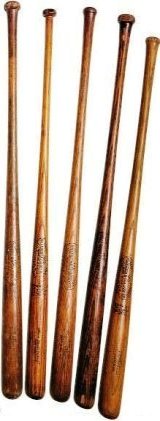|
Fake Bunt, Hit ~ An Effective Way To Get The Defense To React To What They See, Then The Offense Executes Something Entirely Different!
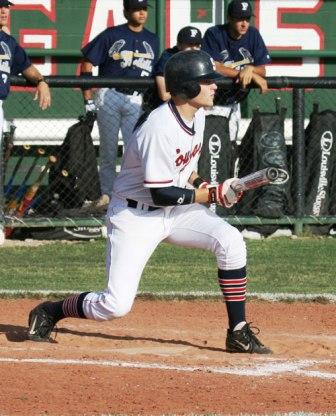
The fake bunt hit, used with runner(s) on 1B, 2B, 1B and 2B, or 1B and 3B. In each situation the runners are running on the pitch, with the exception of the runner on 3B in the first and third scenario.
The hitter sets up as in the photo, alerting the defense to the possible upcoming bunt, which puts the infielders in motion. Each situation requires a somewhat different reaction from the defense, as shown in the diagrahms that follow.
As the pitcher starts to deliver, the hitter pulls the bat back to a hitting position and takes a full cut.
The idea is to fake bunt and hit the ball on the ground, past the pulled in corner infielders, or into the areas vacated by the SS and 2B.
The hitter is required to swing, just as he would in a hit and run situation. If the ball isn't hittable, he covers for the runners by keeping the catcher back.
Just one additional way to provide the defense with something extra to think about.
Like the hit and run, the fake bunt hit can be a good slump buster. Forced to swing the bat and not think, hitters in slumps often find some relief.
Runner On First
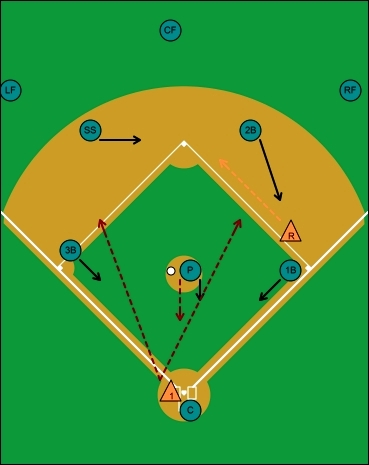
- Runner on first is going on the pitch.
- Hitter shows bunt early. Players need to get a feel for the timing. Shown too early quite often alerts the defense. Shown too late doesn't allow enough time to get the defense into motion.
- As the pitcher starts to deliver, the hitter pulls the bat back and takes a full swing, looking to hit the ball on the ground, either past the charging 3b or 1b, or the spots vacated by the ss and 2b as they move to cover bases.
- The hitter is required to swing, just as he would on a hit and run.
Runner On Second
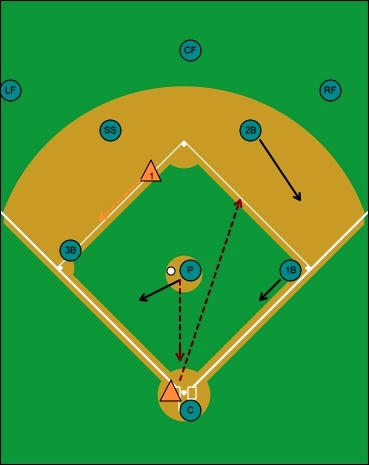
- Runner on second is going on the pitch.
- Hitter shows bunt early.
- Hitter is required to swing, just as he would on a hit and run.
- Defensive movement is different. The 3b will be holding, reading the bunt. The 1b will be crashing, as the 2b goes to cover 1b. The hole created by the stealing runner is at 2b in this situation.
Runner On First And Second
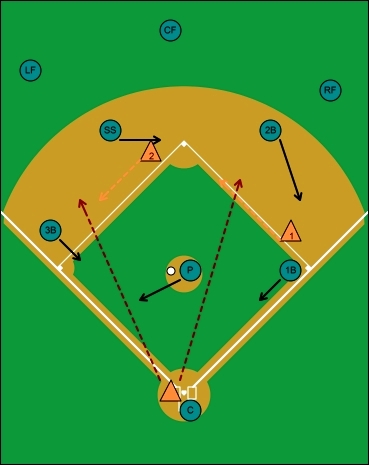
- Runners are going on the pitch.
- Hitter shows bunt early.
- Hitter is required to swing, just as he would in a hit and run. If the ball is not hittable, he is covering for the runners which are then on a straight steal.
- As the pitcher starts to deliver, the hitter pulls the bat back and takes a full swing, looking to hit the ball on the ground, either past the charging 3b or 1b, or the spots vacated by the ss and 2b as they move to cover bases.
Runner On First And Third
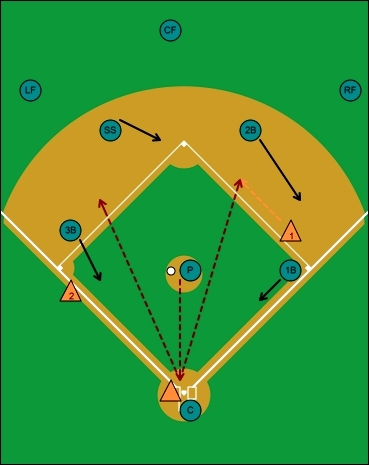
- Runner from first is running on the pitch.
- Runner from third is getting his regular secondary, reading what happens with the hitter.
- Should the hitter not put the ball in play, or hits the ball in the air, the runner from third holds or tags, according to the situation in front of him.
- Hitter is required to swing, just as he would in a hit and run. If the ball is not hittable, he is covering for the runners which are then on a straight steal.
- As the pitcher starts to deliver, the hitter pulls the bat back and takes a full swing, looking to hit the ball on the ground, either past the charging 3b or 1b, or the spots vacated by the ss and 2b as they move to cover bases.
Fake Bunt Hit Tips ~ From The Dugout

Very important that the hitter not show the bunt too early, or too late. Too early alerts the defense that there is something other than a bunt going on. Too late and the hitter will not have enough time to get the bat back to swing.
In all of the situations above, the runners are running on the pitch, with the exception of first and third, where the runner from third is reading the situation created by the hitter.
Should you not like a hit and run in this situation, you can also have the hitter only hitting strikes, depending on how you would like it played. Work the situations to fit within your philosophy.
Additional Offensive Situations
- Offensive Situations
~ Keep your opponents under pressure at all times
- Sacrifice bunts
~ The cornerstone's of offensive situations
- Hit and run
~ Get your offense moving with this exciting and aggressive play
- Bunt and run
~ The short game adrenelin rush
- Fake bunt and steal
~ A great wrinkle to enhance the straight steal, providing your base runner with a little extra protection
- Reading down angles
~ Get the jump on pitches in the dirt, take the extra base
- Special plays
~ Designed to amp up your running game through the element of surprise
- Safety squeeze
~ Initially the safest version, yet the most complicated to execute
- Suicide squeeze
~ A few seconds of pure excitement
- Double squeeze
~ The excitement of the suicide squeeze, with so much more
- Base running
~ One of the least taught, yet still one of the most important, even in the age of the aluminum bat
- Stealing second
~ As you step out into your lead, all the feelings intensify as you lock in on that one movement the pitcher is about to make, a movement that will send you speeding towards second base
- Stealing third
~ Often easier than stealing second
- Steal home
~ Always exciting and a true defensive demoralizer
- Double steal
~ Working to keep up the pressure, get two runners into scoring position or possibly score a run
- Delayed steal
~ Uses the element of surprise, a great equalizer
- Home to first
~ A full out sprint; remember, hustle never has a bad day
- First to second
~ Stay in the moment, be aggressive
- Second to third
~ The base runners first and foremost responsibility is to keep track of the baseball
- Third to home
~ The exception in leadoffs, as you lead off in foul territory
- First to third
~ The added skill involved is to pick up the third base coach, then second base, and the coach again
- 25 ways to score
~ 25 reasons to work hard getting a runner on third base
return from fake bunt hit to the ole ballgame.com
|
Have A Baseball Related Question?
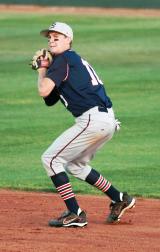 Click the image to visit our question page and have it answered. Due to my increased coaching schedule, I would ask that questions be limited to the following categories: Baseball Instruction, Baseball's Mental Game and Defensive and Offensive Situations. Don't have a question right now? Maybe you'd like to browse through questions already submitted. Each question becomes it's own web page on this site. Step up to the plate and put the ball in play! It only takes a few minutes. Solid resources for other categories: Baseball Resource
|










